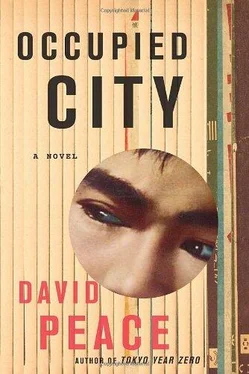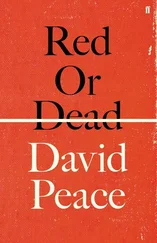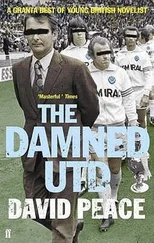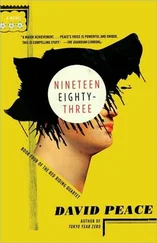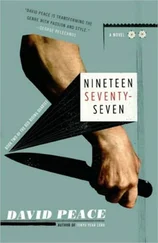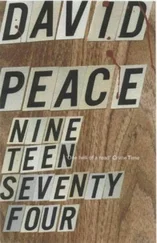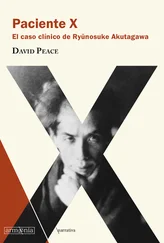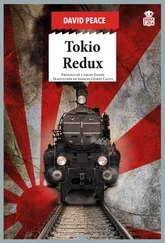Now the Killer stops writing. The Killer seals the letter in an envelope. The Killer posts the envelope to Mr Ishii Shirō, 77 Wakamastu-chō, Ushigome-ku, Tokyo.
Now the Killer waits.
There are those born with strength and those born with weakness / Those who are healthy and those who are sick / There is order in all matter, there is order in all things / There are structures and there are hierarchies / Those of substance and those of none, those who matter and those that don’t / And there is one who matters more than most, the one who matters most of all
In the Death Factory, in the summer of 1940, I was suddenly sent to Xinjing. An outbreak of plague had been reported in one part of the city. As soon as we arrived, we enclosed the entire affected area inside a sheet-metal wall one metre in height and then burnt everything within the enclosure to the ground. We then conducted examinations of all the Japanese and the Chinese who had been living in the area. Finally, we were ordered to dig up the bodies of people who were suspected of having died from the epidemic, to dissect the corpses, to remove and then preserve the organs. My task was to take small specimens from the lungs, livers and kidneys of the corpses. I then applied each to a Petri dish. Organs that tested positive for the plague were taken directly back to the Unit. The Petri dishes of plague germs which I had gathered were first sent to the Xinjing National Hygiene Laboratory to be cultivated and then on to Pingfan.
It was a high-risk job and one of my colleagues became infected. I do not know how it exactly happened but the man developed a high temperature and suddenly collapsed. He was rushed back to the Air Corps Hospital at Harbin, which was a small hospital and easier to isolate. There he was treated by doctors from the Death Factory. I was told he became well enough to travel and was sent to Port Arthur, then to Hiroshima, and finally to a hospital in Morioka. I was also told he received thirty-six yen a month in compensation, which was then double the salary of a school principal, for example. However, I never personally saw or heard from the man again.
On the Black Ship, the Killer gets a reply to his letter.
Early one morning, an American jeep and a car from the Tokyo Metropolitan Police pull up outside the Killer’s address. The police rush up the stairs of the boarding house. The police kick in the door to the Killer’s room. The police ransack the room. The police come back down the stairs. The police talk to the Americans who are standing beside their jeep. The Americans and the police get back into their jeep and their car and they leave.
The Killer steps out of the shadows of the ruined building opposite his former boarding house. The Killer has a knapsack on his back and a doctor’s bag in his hand. The Killer makes his way to Tokyo Station. The Killer boards a train. The Killer leaves the Occupied City. For now.
He is the brightest boy in his class, he has the sharpest memory / He carries himself with authority / He is the tallest boy in his class, he has a magnetic personality / He hypnotizes everyone he meets / He is abrasive, arrogant and brash, and he is almost blind / He idolizes the Emperor Meiji
In the Death Factory, as the war intensified and the number of soldiers multiplied, most of my daily work increasingly concerned venereal disease. Thousands of our soldiers had become infected, with a debilitating effect upon our military capabilities. Often we were sent to perform VD checks and issue health certificates. The brothels were under civilian management and almost all of the women who worked in them were Korean. There were three classifications for the brothels; Class 1 was for officers, Class 2 for noncommissioned officers, and Class 3 for Japanese civilians and enlisted soldiers. However, due to a shortage of brothels and a surfeit of customers, it became common practice to let different units use the Class 1 brothels on certain days at certain times.
My work involved taking blood samples from the women and conducting health examinations. These examinations were known as manju exams. The woman would have to get down on her hands and knees with her buttocks raised. If her sex organ was swollen or discharged any pus it would mean she had been infected with syphilis. On a typical day, I would have to examine over one hundred and fifty women in this manner.
I know that within the Death Factory, research was conducted into venereal diseases with the aim of developing a way to protect soldiers from sexually transmitted diseases. Often I would collect blood samples from women prisoners who had contracted syphilis. These women were usually Chinese prisoners but, on occasion, I collected samples from Russian women. I heard rumours about the ways in which these women had been infected with the disease, that doctors dressed from head to toe in white laboratory clothing, with only their eyes visible, forced male prisoners infected with syphilis to have sex with female prisoners at gunpoint. Also I believe studies were conducted on pregnant prisoners and the effects of syphilis upon the foetus. It was at this time that I took a personal vow of abstinence.
On the Black Ship, the Killer travels across Japan. Day after day, the Killer tries to find a new job. Day after day, the Killer tries to start a new life. But night after night, the Killer goes hungry and cold while night after night, the men the Killer once followed, the men the Killer once served, retire well fed and warm. So night after night, the Killer writes letter after letter; anonymous letters to the Americans, anonymous letters to the Russians; letters listing names, letters detailing crimes. But day after day the letters go unanswered, night after night the guilty go unpunished. And night after night, the Killer’s own memories and nightmares return. Night after night, with the smell of bitter almonds.
In the fifth year of the reign of the Emperor Taishō / At Kyoto Imperial University, in the Medical Department / He sits beside his fellow students, his fellow students here to heal / But he is not here to heal, he is not here to cure / With his knowledge of Western medicines, with his knowledge of Oriental traditions / He is only here to study, he is only here to learn / To study disease, to learn of death
In the Death Factory, the Kwantung Army and, in particular, the Kempeitai had always been concerned about the vulnerability of our water supply to poisoning by Chinese saboteurs. However, from early 1942, this concern seemed to become an obsession and began to consume the majority of our time in Hygiene. It was, though, preferable to the interminable VD inspections.
Each day we would be assigned a different village and sent to check each well in the designated area. We were also required to test the local population for outbreaks or symptoms of anthrax, cholera, typhus and the plague in each location. Often we would be away from the Death Factory for weeks on end.
In the beginning the work was monotonous and generally without incident, though there was always the risk of ambush or attack from Chinese bandits. However, the nearer we worked to the front line or the border with the Soviet Union, the more dangerous our work became. The nature of the work itself also began to change.
On the Black Ship, the Killer finds a job. On 15 September 1947, Typhoon Kathleen strikes the Bōsō Peninsula and the Kanto area. The resulting floods leave over one thousand people dead and hundreds missing and homeless. The affected Ward Offices urgently call for trained staff to assist in the rescue operations and the prevention of disease. The Killer answers their call.
The Killer works tirelessly, day and night, to help prevent the spread of dysentery among the survivors. Finally, here among the dirty flood waters of Saitama and Tochigi, the Killer’s memories begin to recede, his addictions begin to retreat.
Читать дальше
